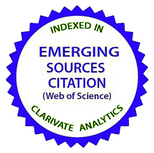Дослідження механізму йонної дифузії та міграційного транспорту в тришарових поліпірольних актуаторах з провідним полімером
DOI:
https://doi.org/10.15330/pcss.26.1.72-77Ключові слова:
дифузія йонів, міграція йонів, провідний полімер, Поліпірольні тришарові актуатори, COMSOLАнотація
Ініціація транспорту йонів у струмопровідних полімерах дозволяє у рівній мірі покладатися як на характеристики матеріалу, так і на методи дослідження. У галузі актуаторів все більше використовують провідні полімери. У цьому дослідженні застосовано модуль електростатики скінченно-елементної моделі COMSOL Multiphysics для вдосконалення існуючих методів моделювання і розуміння механізму дифузії та міграції йонів у шаруватих струмопровідних полімерах, зокрема, в тришарових поліпіролових актуаторах. Модель контролює специфічну картину потоку і часовий прогрес електричної напруги, концентрацій катіонів і аніонів. Модель використовує лише характеристики матеріалу для прогнозування структурних деформацій у тришарових актуаторах, що вказує на її потенційну практичну користь. Крім того, вона не залежить від зразка, що робить її цінною для застосування в електроактивних полімерах. Оцінка з використанням наявних даних демонструє, що прогнози симуляції збігаються з високою точністю в усьому діапазоні оцінених вхідних потенціалів, що додатково підтверджує її надійність та ефективність.
Посилання
G.G. Wallace, et al., Intelligent Polymer Systems, Third Edition. Conductive Electroactive Polymers, 268 (2008); https://doi.org/10.1201/9781420067156.
B.L. Lee, Electrically conductive polymer composites and blends. Polymer Engineering & Science, 32(1), 36 (1992).
W. Zhang, A.A. Dehghani-Sanij, and R.S. Blackburn, Carbon based conductive polymer composites. Journal of materials science, 42(10), 3408 (2007); https://doi.org/10.1007/s10853-007-1688-5.
O. Bubnova, et al., Semi-metallic polymers. Nature materials, 13(2), 190 (2014); https://doi.org/10.1038/nmat3824.
Y. Xia, K. Sun, and J. Ouyang, Solution‐Processed Metallic Conducting Polymer Films as Transparent Electrode of Optoelectronic Devices. Advanced Materials, 24(18), 2436 (2012); https://doi.org/10.1002/adma.201104795.
K. Gurunathan, et al., Electrochemically synthesised conducting polymeric materials for applications towards technology in electronics, optoelectronics and energy storage devices. Materials Chemistry and Physics, 61(3), 173 (1999); https://doi.org/10.1016/S0254-0584(99)00081-4.
T. Park, et al., Flexible PEDOT electrodes with large thermoelectric power factors to generate electricity by the touch of fingertips. Energy & Environmental Science, 6(3), 788 (2013); https://doi.org/10.1039/C3EE23729J.
F. Liu, et al., Surface modification of polythiophene and poly (3‐methyl thiophene) films by graft copolymerization. Journal of Applied Polymer Science, 123 (5), 2582 (2012).
J. Simitzis, D. Triantou, and S. Soulis, Synthesis and characterization of electrically conducting copolymers based on benzene and biphenyl. Journal of applied polymer science, 110(1), 356 (2008); https://doi.org/10.1002/app.28477.
H.-K. Choi, et al., Electro-optical and electrochemical properties of poly (2-ethynylthiophene). Journal of Industrial and Engineering Chemistry, 18(2), 814 (2012); https://doi.org/10.1016/j.jiec.2011.10.005.
R.B. Seymour, New Horizons in Conductive Polymers, in Conductive Polymers 1 (1981).
T. Ito, H. Shirakawa, and S. Ikeda. Simultaneous polymerization and formation of polyacetylene film on the surface of concentrated soluble Ziegler-type catalyst solution, J. Polym. Sci., Polym. Chem. Ed, 12(1), 11 (1974); https://doi.org/10.1002/pol.1974.170120102.
J. Mort, Conductive polymers. Science, 208, 819 (1980); https://doi.org/10.1126/science.208.4446.819.
J.R. Fried, Polymer Science and Technology. (Prentice Hall 2014).
R. Waltman, and J. Bargon, Electrically conducting polymers: a review of the electropolymerization reaction, of the effects of chemical structure on polymer film properties, and of applications towards technology. Canadian Journal of Chemistry, 64(1), 76 (1986); https://doi.org/10.1139/v86-015.
G. Inzelt, Conducting Polymers: A New Era in Electrochemistry. (Springer Berlin Heidelberg 2012.)
J. Madden, Polypyrrole actuators: Properties and initial applications, in Electroactive Polymers for Robotic Applications: Artificial Muscles and Sensors. Springer. 121 (2007).
R. Temmer, et al., Combined chemical and electrochemical synthesis methods for metal-free polypyrrole actuators. Sensors and Actuators B: Chemical, 166, 411 (2012); https://doi.org/10.1016/j.snb.2012.01.075.
C. Chan, S. Chang, and H.E. Naguib, Development and characterization of polypyrrole bi-layer and tri-layer thin porous films. Smart materials and structures, 18(10), 104022 (2009); https://doi.org/10.1088/0964-1726/18/10/104022.
J.D. Madden, et al., Artificial muscle technology: physical principles and naval prospects. Oceanic Engineering, IEEE Journal of, 29(3); 706 (2004); https://doi.org/10.1109/JOE.2004.833135.
P.G. Pickup, and R.A. Osteryoung, Charging and discharging rate studies of polypyrrole films in AlCl3: 1-methyl-(3-ethyl)-imidazolium chloride molten salts and in CH3CN. Journal of electroanalytical chemistry and interfacial electrochemistry, 195(2), 271 (1985); https://doi.org/10.1016/0022-0728(85)80048-6.
J. Lacroix, K. Fraoua, and P. Lacaze, Moving front phenomena in the switching of conductive polymers. Journal of Electroanalytical Chemistry, 444(1), 83 (1998).
D. Edwards, Non-Fickian diffusion in thin polymer films. Journal of Polymer Science-B-Polymer Physics Edition, 34(5), 981(1996).
N. Schlotter, and P. Furlan, A review of small molecule diffusion in polyolefins. Polymer, 33(16), 3323 (1992); https://doi.org/10.1016/0032-3861(92)91089-K .
R.C. Alkire, Special review transport processes in electrochemical systems. Chemical Engineering Communications, 38(3-6), 401 (1985); https://doi.org/10.1080/00986448508911318.
P.G., Madden, et al., The relation of conducting polymer actuator material properties to performance. Oceanic Engineering, IEEE Journal of, 29(3), 696 (2004); https://doi.org//10.1109/JOE.2004.833139.
X. Wang, B. Shapiro, and E. Smela, Development of a model for charge transport in conjugated polymers. The Journal of Physical Chemistry C, 113(1), 382 (2008); https://doi.org/10.1021/jp802941m.
##submission.downloads##
Опубліковано
Як цитувати
Номер
Розділ
Ліцензія
Авторське право (c) 2025 Azeez A. Barzinjy, Muhammad Husham, Banaz S. Haji, Kadhim Q. Jabbar

Ця робота ліцензованаІз Зазначенням Авторства 3.0 Міжнародна.










